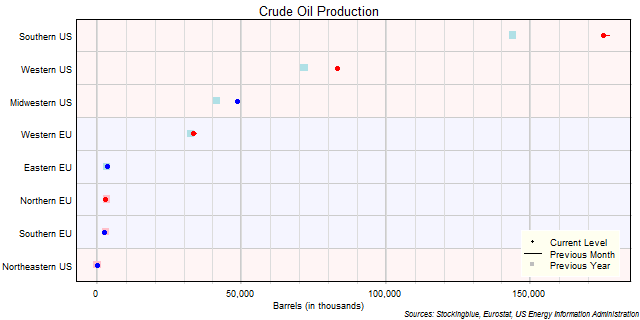
The chart above shows the crude oil production in each EU and US region as of January 2019 in thousands of barrels, the change from the previous month, and the production one year prior. The Northeast produces almost no crude at all.
Findings
- The difference between the region with the greatest production, the Southern US, and the region with the least, the Northeastern US, is 174,934 thousand barrels (down from 177,354 last month and up from 143,850 last year). The South and the Northeast had the greatest and least production respectively both last month and last year.
- The South has 352.98 times the production that the Northeast does. The ratio of highest production to lowest production was down from 395.12 last month and up from 272.93 last year.
- Zero regions saw no change in their crude production from the previous month, four produced more, and four regions produced less.
- Zero regions saw no change in their crude production from last year, while five increased production, and three decreased production.
Caveats
- Data is from January 2019 except for Greece, Malta, and the Netherlands which are from December 2018 and Germany which is from November 2018.
- The figures for EU states are converted from metric tons to barrels at a rate of 7.33 barrels to the metric ton which is the number the US uses for the conversion. This figure may vary depending on the type of crude, and different countries use different measures for the conversion since the number of barrels per metric ton can range from six to eight barrels depending on the crude.
- All figures are rounded to the nearest hundredth.
- The Southern US consists of Texas, Florida, Georgia, North Carolina, Virginia, Tennessee, Louisiana, South Carolina, Alabama, Kentucky, Oklahoma, Arkansas, Mississippi, and West Virginia.
- The Western US consists of California, Washington, Colorado, Arizona, Oregon, Utah, Nevada, New Mexico, Hawaii, Idaho, Alaska, Montana, and Wyoming.
- The Midwestern US consists of Illinois, Ohio, Michigan, Indiana, Minnesota, Wisconsin, Missouri, Iowa, Kansas, Nebraska, North Dakota, and South Dakota.
- The Western EU consists of Germany, United Kingdom, France, Netherlands, Belgium, Austria, Ireland, and Luxembourg.
- The Eastern EU consists of Poland, Czech Republic, Romania, Hungary, Slovakia, Bulgaria, Croatia, Slovenia, Lithuania, Latvia, and Estonia.
- The Northern EU consists of Sweden, Denmark, and Finland.
- The Southern EU consists of Italy, Spain, Portugal, Greece, Cyprus, and Malta.
- The Northeastern US consists of New York, Pennsylvania, New Jersey, Massachusetts, Maryland, Connecticut, New Hampshire, Delaware, Maine, Rhode Island, and Vermont.
Details
In absolute terms, the Southern US saw the largest decrease over the previous month with a drop of 2,373 thousand barrels. The Midwest had the biggest spike in production with a gain of 113 thousand barrels. Year over year, the Northern EU had the largest decrease with a drop of 586.40 thousand barrels while the Southern US had the greatest increase with a gain of 31,052 thousand barrels.
In relative terms, the Northern EU had the greatest decrease over the previous month with a 13.71% drop in production while the Northeastern US had the greatest increase with a 10.44% gain in production. Year over year, the Northern EU had the greatest decrease with a 15.01% drop in its production while the Southern US had the greatest increase with a 21.51% gain in production.
The Southern US accounted for nearly half the production of crude in the EU and US at 49.77%. It, with the Western US accounted for just under three-fourths of the entire crude production in the EU and US at 73.47%.
The Eastern EU went from being the sixth largest producer last month and last year to the fifth largest producer of crude this past month surpassing the Northern EU.
Sources
Eurostat. 2019. "Supply and Transformation of Oil - Monthly Data." Accessed May 15, 2019. http://appsso.eurostat.ec.europa.eu/nui/show.do?query=BOOKMARK_DS-075785_QID_-78955871_UID_-3F171EB0&layout=TIME,C,X,0;GEO,L,Y,0;UNIT,L,Z,0;PRODUCT,L,Z,1;INDIC_NRG,L,Z,2;INDICATORS,C,Z,3;&zSelection=DS-075785INDICATORS,OBS_FLAG;DS-075785PRODUCT,3105;DS-075785INDIC_NRG,B_100100;DS-075785UNIT,THS_T;&rankName1=UNIT_1_2_-1_2&rankName2=INDICATORS_1_2_-1_2&rankName3=PRODUCT_1_2_-1_2&rankName4=INDIC-NRG_1_2_-1_2&rankName5=TIME_1_0_0_0&rankName6=GEO_1_2_0_1&sortC=ASC_-1_FIRST&rStp=&cStp=&rDCh=&cDCh=&rDM=true&cDM=true&footnes=false&empty=false&wai=false&time_mode=NONE&time_most_recent=false&lang=EN&cfo=%23%23%23%2C%23%23%23.%23%23%23.
US Energy Information Administration. 2019. "Crude Oil Production." Accessed May 14, 2019. https://www.eia.gov/dnav/pet/pet_crd_crpdn_adc_mbbl_m.htm.